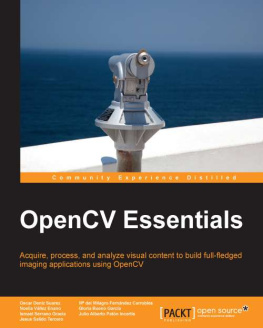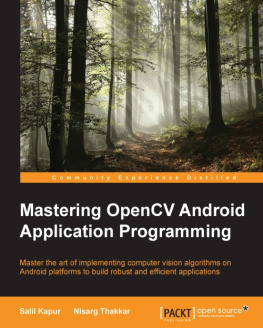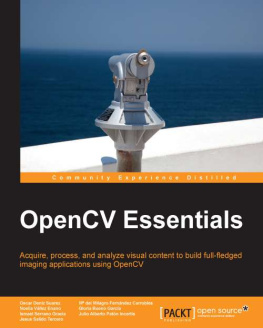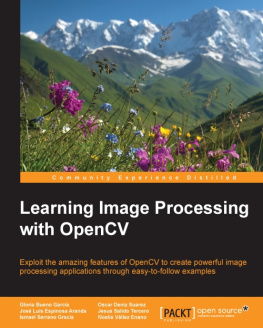About the Authors
Oscar Deniz Suarez is the author of more than 50 refereed papers in journals and conferences. His research interests are mainly focused on computer vision and pattern recognition. He received the runner-up award for the best PhD work on computer vision and pattern recognition by AERFAI and the Image File and Reformatting Software challenge award by InnoCentive Inc. He has been a national finalist at the 2009 Cor Baayen awards. His work is being used by cutting-edge companies such as Existor, GLIIF, TapMedia, E-Twenty, and others and has also been added to OpenCV. Currently, he works as an associate professor at the University of Castilla-La Mancha and contributes to Visilabs. He is a senior member of IEEE and is affiliated with AAAI, SIANI, CEA-IFAC, AEPIA, AERFAI-IAPR, and The Computer Vision Foundation. He serves as an academic editor for the journal PLoS ONE. He has been a visiting researcher at Carnegie Mellon University, Pennsylvania, USA; Imperial College, London, UK; and Leica Biosystems, Ireland. He has co-authored a book on OpenCV programming for mobile devices.
M del Milagro Fernndez Carrobles received her Bachelor's degree in Computer Science and Master's degree in Physics and Mathematics from the University of Castilla-La Mancha, Spain, in 2010 and 2011, respectively. She is currently a PhD candidate and works at Visilabs. Her research interests include image processing and artificial intelligence, especially in medical imaging.
I would like to thank my parents for their love and support. Without them, I would never have gotten where I am today. I also thank Jorge for his limitless patience.
Noelia Vllez Enano liked computers since childhood, although she didn't have one before her mid-teens. In 2009, she finished her studies in Computer Science through the University of Castilla-La Mancha. She started her work at the Visilabs group through a project about mammography CAD systems and electronic health records. Since then, she has obtained a Master's degree in Physics and Mathematics and has enrolled for a PhD degree. Her work involves using image processing and pattern recognition methods. She also likes to teach and work in other areas of artificial intelligence.
I would like to thank Jose and the rest of my family for all their support throughout these years and specially now that I am writing this book 2200 km away from them.
Gloria Bueno Garca holds a PhD in Machine Vision from Coventry University, UK. She has experience working as a principal researcher in several research centers, such as UMR 7005 research unit CNRS, Louis Pasteur University, Strasbourg, France; Gilbert Gilkes and Gordon Technology, UK; and CEIT San Sebastian, Spain. She is the author of two patents, one registered software, and more than 100 refereed papers. Her interests are in 2D/3D multimodality image processing and artificial intelligence. She leads the Visilabs research group at the University of Castilla-La Mancha. She has co-authored a book on OpenCV programming for mobile devices.
Ismael Serrano Gracia received his Bachelor's degree in Computer Science in 2012 from the University of Castilla-La Mancha. He scored the highest marks in his final degree project about human detection. This application uses depth cameras with OpenCV libraries. He is currently a PhD candidate at the same university, holding a research grant from the Spanish Ministry for Science and Research. He is also working at the Visilabs group as an assistant researcher and developer on different computer vision topics.
Julio Alberto Patn Incertis graduated from the University of Castilla-La Mancha. He started developing computer vision applications as part of his Master's degree project in Computer Science. He has focused on mobile devices, mainly Android; he has created a mobile application for this platform that is capable of locating, tracking, and recognizing text for blind people. This application was later used as a part of a patent-pending indoor positioning system. OpenCV has been an essential part of all his projects.
Thanks to my parents, as their huge efforts allowed me to obtain a degree at the university. I would also like to thank the Visilabs research group for giving me the opportunity to start developing computer vision applications.
Jesus Salido Tercero gained his Electrical Engineering degree and PhD (1996) at Universidad Politcnica de Madrid, Spain. He then spent 2 years (1997/98) as a visiting scholar at The Robotics Institute (Carnegie Mellon University, Pittsburgh, USA), working on cooperative multirobot systems. Since his return to the Spanish university of Castilla-La Mancha, he divides his work time between teaching courses on robotics and industrial informatics and researching on vision and intelligent systems. For the past 3 years, his efforts have been directed to develop vision applications on mobile devices. He has co-authored a book on OpenCV programming for mobile devices.
To my three precious jewels: Dorita, Juan Pablo, and Jacobo.



![Nicolas Modrzyk [Nicolas Modrzyk] - Java Image Processing Recipes: With OpenCV and JVM](/uploads/posts/book/119384/thumbs/nicolas-modrzyk-nicolas-modrzyk-java-image.jpg)


